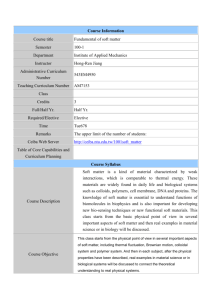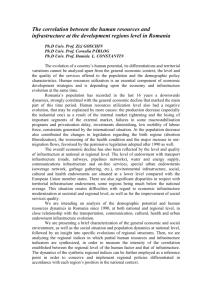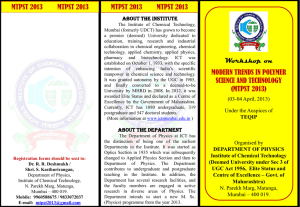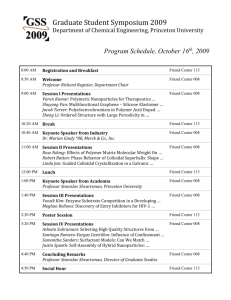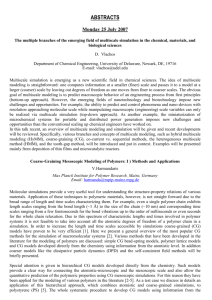Life at High Péclet Numbers
advertisement
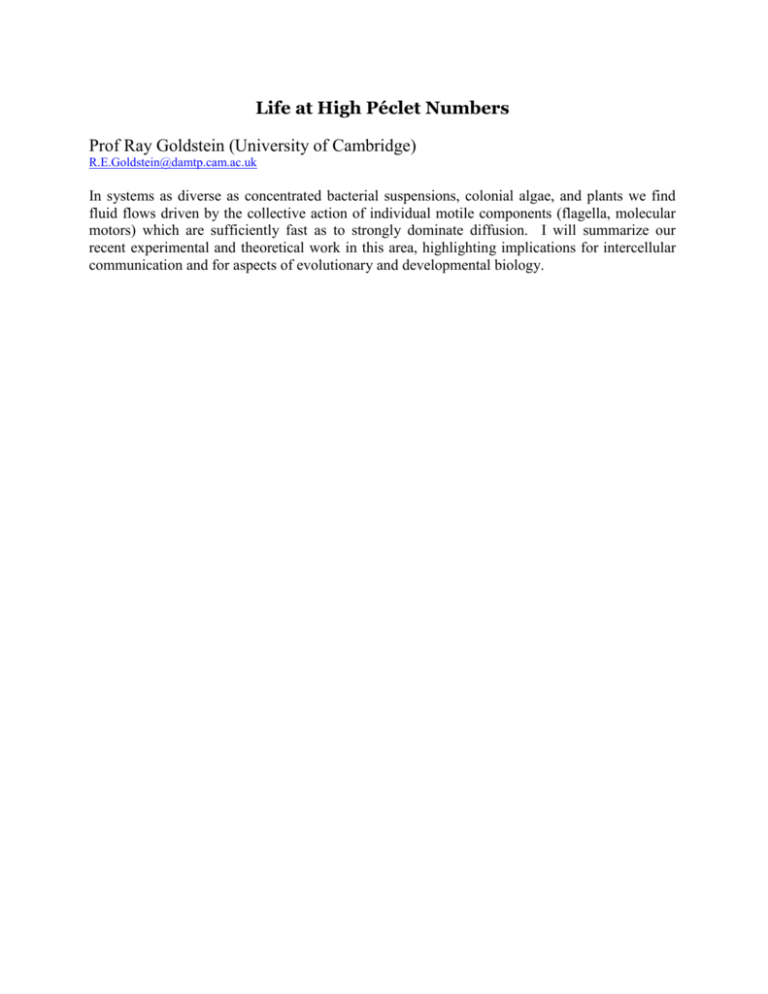
Life at High Péclet Numbers Prof Ray Goldstein (University of Cambridge) R.E.Goldstein@damtp.cam.ac.uk In systems as diverse as concentrated bacterial suspensions, colonial algae, and plants we find fluid flows driven by the collective action of individual motile components (flagella, molecular motors) which are sufficiently fast as to strongly dominate diffusion. I will summarize our recent experimental and theoretical work in this area, highlighting implications for intercellular communication and for aspects of evolutionary and developmental biology. Designing swimmers powered by chemical reactions Prof Ramin Golestanian (University of Sheffield) r.golestanian@sheffield.ac.uk A simple model for the reaction-driven propulsion of a small device is proposed as a model for a molecular swimmer in aqueous media. Motion of the device is driven by an asymmetric distribution of reaction products. Experimental realization of this device at Sheffield will be reported together with the quantitative analysis of the observed motion. Swimming with a friend at low Reynolds Number Dr Chris Pooley (University of Oxford) c.pooley1@physics.ox.ac.uk Microscopic swimmers are devices (typically microns in size) which move from place to place by self-inducing a periodic shape change. There are many well known biological examples. For instance, sperm cells set up distortions which propagate down a long, thin filament known as a flagellum. The physics of swimming on such small length scales is somewhat different to our everyday understanding. This is principally related to a quantity known as the Reynolds number, a dimensionless measure which characterises the importance of inertia within a system. In this talk I will focus on the hydrodynamic interaction between two model microscopic swimmers. I will show that this long range coupling is made up of two parts; a ``dead'' term, independent of the motion of the second swimmer, which takes the expected dipolar form and a ``live'' term resulting from the simultaneous swimming action of both swimmers which does not. I will argue that the latter dominates. This results in the swimmer-swimmer interaction being a complicated function of their relative displacement, orientation and phase, leading to trajectories that can be attractive, repulsive or oscillatory. Collective hydrodynamics of active swimmers Prof Ignacio Pagonabarraga (University of Barcelona) ipagonabarraga@ub.edu The dynamics of active microorganisms is affected by the fluid in which they are suspended, since it interferes with the internal mechanisms which generate their propulsion. I will analyze the collective behavior which emerges out of swimmers’ dissipative interactions. Instead of focusing on the molecular means which lead to particle motility, I will consider schematic propulsion processes and will analyze the implications of organisms interactions. To this end, I will present results obtained with mesoscopic simulation which capture the appropriate dynamic coupling, and will characterize the different dynamical regimes of these propellers, exploring their analogies with the dynamics of colloidal suspensions. I will also consider the behavior of suspensions of active rotators, a model system for some intermembrane proteins, where the hydrodynamic coupling leads to cooperative motility. Semiflexible Polymers and Filaments: From Single Polymers to Biological Structure Prof Jan Kierfeld (Max Planck Institute of Colloids and Interfaces) Jan.Kierfeld@mpikg.mpg.de Semiflexible polymers and filaments play an important role in biological and chemical physics. Single filaments are characterized by a certain bending rigidity which governs their fluctuation behaviour and structure formation. First, I discuss thermal fluctuations of single filaments in well-defined confined geometries. On the level of active non-equilibrium systems consisting of many interacting filaments, new ordering effects occur. I will discuss motility assays, where cytoskeletal filaments are adsorbed and driven by motor proteins, which are anchored to a planar two-dimensional substrate. The interaction with motor proteins leads to an enhanced (nematic) ordering of filaments. The Universal Hydrodynamics of Self-driven Particle Systems Prof Sriram Ramaswamy (Indian Institute of Science) sriram@physics.iisc.ernet.in Collections of self-driven or ``active'' particles are now widely recognised as a distinct kind of nonequilibrium matter, whose phases differ in crucial qualitative ways from those of equilibrium systems with the same spatial symmetry. My talk will present a brief update on our research on active rheology, and then move to two new topics: experiments on active nematics in vibrated granular monolayers, and theory and simulation on a Brownian inchworm model of selfpropulsion. Hydrodynamics and rheology of active gels: Lattice Boltzmann simulations Dr Davide Marenduzzo (University of Edinburgh) dmarendu@ph.ed.ac.uk We report numerical studies, via lattice Boltzmann simulations, of the hydrodynamics and of the rheology of an active gel (a concentrated bacterial fluid or actomyosin solution). We first confirm the existence of a transition between a passive and an active viscoelastic gel in which there is spontaneous flow in steady state, and map out the full stability diagram for fixed boundary conditions. We then present simulations of shear and Poiseuille flow both in the passive and in the active phase. We find that the rheology of an active liquid crystalline gel strikingly departs from that of its passive counterpart, so that an active material can thicken or thin under a flow, or even exhibit both behaviours as the forcing changes. Nanometre-scale machinery made from DNA Prof Andrew Turberfield (University of Oxford) a.turberfield@physics.ox.ac.uk DNA is a wonderful material for nanoscale construction. It is a structural material whose selfassembly can be programmed by making use of information stored in its base sequence. DNA hybridization can also be used as an energy source for molecular devices. I shall describe our recent work on self-assembled DNA polyhedra [1] and their applications in three-dimensional nanofabrication and as molecular cages [2] and our progress towards the construction of a freerunning synthetic molecular motor fuelled by DNA [3]. [1] R. P. Goodman et al., Science 310, 1661-1665 (2005). [2] C. M. Erben, R. P. Goodman, A. J Turberfield, Angew. Chem. Int. Ed 45, 7414-7417 (20006). [3] B. Yurke et al., Nature 406, 605-608 (2000); A. J. Turberfield et al.,Phys. Rev. Lett. 90, 118102 (2003); P. Yin et al., Angew. Chem. Int. Ed. 43, 4906-4911 (2004); J. Bath, S. J. Green, and A. J. Turberfield, Angew. Chem. Int. Ed. 44, 4358-4361 (2005); S. J. Green, D. Lubrich and A. J Turberfield, Biophys. J., 91, 2966-2975 (2006). Multiscale Modelling in Polymer Science: from atomistic to mesocale simulations Dr Giuseppe Milano (University of Salerno) gmilano@unisa.it The production of polyolefins, is a large-scale industry with an estimated annual world production of about 60 million tons. The trend is rising, with a predicted growth of over 50% over the next ten years. Polymeric materials based of polyolefins are used for a legion of applications in a wide array of technological areas. Completely new polymer products, like syndiotactic polypropylene and syndiotactic polystyrene are industrially available. In this field, atomistic simulations can provide information about structure properties relations at very detailed level. The extension of simulation techniques to larger space and timescales is one of the main goals of current research in polymeric materials. Relaxing long chains in a dense material even in the bulk is not trivial. The time and the length scale associated with the relaxation of long polymer chains are out of reach of fully atomistic molecular dynamics simulations. One way to circumvent this problem is to reduce the degrees of freedom by coarsening the models and keeping only those degrees of freedom that are deemed relevant for the particular range of interest. The most recent activity of MolNac in the field of development and application of multiscale modeling techniques to polymeric material science will be reviewed. Information coming from atomistic simulation are mapped in a coarse-grained model able to reproduce the properties of a reference system. [1-3] The resulting models can be used to simulate large molecular weight polymer melts impossible to treat at full atomistic level and in connection with connectivity altering Monte Carlo algorithms can be used to simulate very long chains up to the molecular weight of commercial samples (2000 repeating units).4 Finally, the configuration obtained at the mesoscale level cab be used to reverse-map atomistic descriptions of the materials. A fast and efficient method based on quaternion algebra and used very recently to obtain atomistic models of polymer melts validated against several experimental data will be also presented.5 References [1] For a recent review see: Müller-Plathe, F. ChemPhysChem 2002, 3, 754. [2] Milano, G.; Goudeau, S.; Müller-Plathe, F. J. Polym. Sci. Part B: Polymer Physics 2005, 43, 871. [3] Milano, G; Müller-Plathe, F. J. Phys. Chem. B 2005, 109, 18609. [4] Spyriouni, T.; Tzoumanekas, C.; Theodorou, D.; Muller-Plathe, F.; Milano, G. Macromolecules; 2007; 40 , 3876. [5] Santangelo, G.; Di Matteo, A.; Muller-Plathe, F.; Milano, G. J. Phys. Chem. B 2007, 111, 2765 Mesoscopic modelling of flow-induced phase transitions of complex fluids Dr Xue-Feng Yuan (University of Manchester) xue-feng.yuan@manchester.ac.uk We have solved the two-fluid model numerically in a high Weissenberg Number and infinite Peclet number in two- and three-dimensional shear flow regime. The simulations have captured key features of flow-induced phase transitions, such as the shift in the phase boundary from its equilibrium position. Conducting simulations in three dimensions has also allowed us to observe the formation of structure in the vorticity direction, and study the role of the second normal stress difference in phase transitions. Dynamic phase diagrams have been obtained for steady state flow. We shall review and present our recent results, and then discuss a general strategy for applying the two-fluid model in a multiple scale modelling of complex fluids. Postive design for self-assembly: from DNA nanostructures to virus capsids Dr Ard Louis (University of Oxford) ard.louis@physics.ox.ac.uk Ard Louis, Jonathan Doye, Iain Johnston, Anna Lewis, Tom Ouldridge, Alex Wilber The remarkable ability of biological matter to robustly self-assemble into well defined composite objects excites the imagination, suggesting that these processes could perhaps be emulated through the judicious design of synthetic building blocks. We employ computer simulations to design particles that reversibly self-assemble into well defined three dimensional composite objects. Examples include DNA nano-structures, virus capsids, and monodisperse complexes made of patchy particles (colloids). The dynamics of assembly can be subtle, including mechanisms such as step by step growth as well as indirect pathways through disordered intermediates. We also investigate the evolutionary dynamics of the self-assembly of quaternary structure in proteins and show how this can explain observed trends extracted from the protein database. Designing Patterned Substrates to Manipulate Compliant Microcapsules Dr Alexander Alexeev (University of Pittsburgh) ala31@pitt.edu We have recently developed a novel mesoscale computational approach for fluid-structure interaction that integrates the lattice Boltzmann method for hydrodynamics and the lattice spring model for the micromechanics of elastic solids. We successfully applied this approach to probe the dynamics of fluid filled elastic capsules that are immersed in a host solution and driven to move across adhesive, polymeric substrates. Our hybrid model allows us to examine how polymeric substrates decorated with mechanical and adhesion features can be used to sort, guide and selectively destroy synthetic microcapsules and ex-vivo biological cells. Achieving large slip with superhydrophobic surfaces: theoretical predictions and experimental measurements for water past carbon nanotube forests Dr Catherine Barentin (Université Claude Bernard LYON 1) barentin@lpmcn.univ-lyon1.fr We investigate, both theoretically and experimentally, the hydrodynamic friction properties of superhydrophobic surfaces and quantify their super-lubricating potential. On such surfaces, the contact of the liquid with the solid roughness is minimal, while most of the interface is a liquidgas one, resulting in strongly reduced friction. On the theoretical side, we obtain scaling laws for the effective slip length in terms of the surface characteristics (roughness length scale, depth, solid fraction of the interface), which we successfully compare to numerical results in various geometries (grooves, posts or holes). On the experimental side, superhydrophobic surfaces made of carbon nanotube forest are studied in a microchannel geometry. Using micro-PIV technique for submicrometer-resolution flow profiling, we measure surface frictional properties in good agreement with our theoretical predictions. Superhydrophobic Materials: Properties and Surfaces Prof Glen McHale (Nottingham Trent University) glen.mchale@ntu.ac.uk When a surface has both topographic structure and hydrophobic (or hydrophilic) surface chemistry its wetting properties are enhanced. A range of example surfaces from model surfaces constructed by lithographic techniques, through ones using simple electrodeposition, to granular materials representing naturally occurring water repellent soils, will be presented and their properties discussed. The conditions under which a liquid ceases to infiltrate into a porous or granular material and the material converts into a one with a superhydrophobic surface will be described using a model hexagonal close packed array of hydrophobic beads. When grains in a surface are not fixed in position, but can be shaped by a droplet deposited upon them, an active process of lifting, self-coating and selectively concentrating small solid grains can be initiated by evaporation. From surface free energy considerations, the sorting of these grains is a result of particles of different wettabilities competing for water-air interfacial surface area. As a result, reduction in droplet volume leads to the formation of temporary liquid marbles (droplets with particulate skins) and the eventual self-organisation of a mixed hydrophobic-hydrophilic aggregate into a hydrophobic shell surrounding a hydrophilic core. Macroscopic Properties of Polar Nematic Liquid Crystals Prof Helmut Brand (University of Bayreuth) brand@uni-bayreuth.de H.R. Brand, H. Pleiner, and F. Ziebert We discuss the macroscopic equations for polar nematic liquid crystals. In this system the macroscopic polarization, P, representing polar order, is an independent macroscopic variable. We show that macroscopic effects unknown from usual nematic liquid crystals, including pyroelectricity and related effects, are expected to arise for polar nematics. Modelling particle dynamics in complex fluids Prof Colin Denniston (Universtiy of Western Ontario) cdennist@uwo.ca We use a lattice Boltzmann algorithm to simulate the immersion of objects in simple and complex fluids. This allows objects to move and interact via full hydrodynamic interactions. We demonstrate our method with a few examples: Spherical (colloid) particles in a simple fluid, spherical particles in a liquid crystal (with Saturn-ring defects), and a ferromagnetic nanowire in a nematic liquid crystals. In the last case, we show that by manipulating the nanowire via a magnetic field it is possible to ascertain elastic properties of the surrounding fluid. Dynamical Simulations on Morphological Transitions of Block Copolymers Prof Toshihiro Kawakatsu (Tohoku University) kawakatu@cmpt.phys.tohoku.ac.jp We report the results of the modelling and computer simulations based on the dynamic selfconsistent field (SCF) theory on the morphological transitions between mesophases of block copolymers upon applying an external field such as a flow field or an electric field. We discuss the kinetic pathways of these transitions and the intermediate transient states. We also discuss how the microscopic chain dynamics is introduced into the mesoscopic SCF theories on polymeric systems. The kinetics and dynamics underlying phase transitions in lyotropic liquid crystals Dr Pavlik Lettinga (Forschungszentrum Jülich) p.lettinga@fz-juelich.de The nature of the isotropic to nematic and nematic to smectic phase transitions of colloidal rod dispersions has been a subject of investigations since the pioneering work of Onsager in 1949. In this talk we add to this discussion in two ways. First, we investigate the dynamics of single fluorescently labeled rod-like viruses (fd) in a background isotropic, nematic and smectic phase using video microscopy, looking for a dynamic signature of these phase transitions. Second, the kinetics of the isotropic-nematic phase transition is studied for a mixture of fd and polymer (dextran), which effectively constitutes a system of attractive rods. In order to do so we apply different techniques to perform a quench from one phase to the other. From the different kinetic path ways for the phase separation, which depend on the depth of the quench, we determine the spinodal point where the system becomes unstable. The experiments on spinodal decomposition of the rod dispersions support very recent theory, where it is shown that the concentration of the rods is enslaved by their orientation. Phase winding in chiral liquid crystalline monolayers due to Lehmann effects Dr Daniel Svensek (University of Ljubljana) daniel.svensek@fmf.uni-lj.si We model recent experimental results by Tabe and Yokoyama [1] on chiral liquid crystalline monolayers driven by the transmembrane transfer of water molecules. The experiment has been recently interpreted in terms of a reaction- diffusion-type process [2], while we claim that it can by explained by, and most probably is, a liquid crystal phenomenon [3]. We point out that the `target' patterns found for the orientation of the in-plane preferred direction can be described as phase winding due to Lehmann effects, which are specific to macroscopically chiral systems. The model presented has only one variable -- the director -- and is driven and dissipative. Including the effects of noise leads to an accurate representation of the patterns observed experimentally. Future experimental tests of the model are suggested. [1] Y. Tabe, H. Yokoyama, Nature Materials 2003, 2, 806 [2] T. Shibata, A. S. Mikhailov, Europhys. Lett. 2006, 73 (3), 436 [3] D. Svensek, H. Pleiner, and H. R. Brand, Phys. Rev. Lett. 2006, 96, 140601 Many body dynamic interactions in colloidal suspensions studied by a fluid particle dynamics method Prof Hajime Tanaka (Institute of Industrial Science, University of Tokyo) tanaka@iis.u-tokyo.ac.jp Dynamics of colloidal suspensions are seriously affected by hydrodynamic interactions between particles. However, hydrodynamic effects are quite difficult to deal with because of the longrange nature and the resulting strong nonlocal couplings among all the relevant degrees of freedom of colloidal suspensions. To get rid of this difficulty, we proposed a new simulation method [Fluid Particle Dynamics (FPD) method]. By applying this method, we discuss a few interesting phenomena, which are caused by dynamic couplings between colloid motion and additional degrees of freedom in the surrounding complex liquids through the flow field. Computational Phlebology Dr Gavin Buxton (Durham University) g.a.buxton@durham.ac.uk Vein valves ensure the unidirectional flow of blood back to the heart and their malfunction can be debilitating or even fatal. It is, therefore, important to understand the physics of vein valves and identify possible treatments for venous diseases. We have recently developed, for the first time, a computer model of a vein valve. By coupling the lattice Boltzmann and lattice spring model techniques we can capture the complex fluid-structure interactions that occur during the opening and closing of vein valves. Furthermore, we hope to extend the model to capture dysfunctional vein valves and gain a better understanding of the physics of surgical, and other less intrusive, treatments. Non-circular inclusions in smectic-C films: the use of FEM Mr Nuno Silvestre (University of Lisbon) nunos@cii.fc.ul.pt We present the use of the finite elements method to study smectic-C free standing films. In particular, we will discuss the shape of soft colloids in free standing smectic-C films, which has been the object of some experiments of Cluzeau and co-workers [1,2]. [1] P. Cluzeau, G. Joly, H.T. Nguyen, and V.K. Dolganov, JETP Lett. 75, 482 (2002). [2] P.V. Dolganov, H.T. Nguyen, G. Joly, V.K. Dolganov, and P. Cluzeau, Europhys. Lett. 78, 66001 (2007). Hydrodynamic effects in lamellar ordering. Prof Giuseppe Gonnella (University of Bari) gonnella@ba.infn.it Ordering of lamellar phases described by a short-range free-energy functional has been numerically investigated by Lattice Boltzmann and Pseudospectral Methods. The ordering process is found to depend on the fluid viscosity: It is arrested for large viscosity values and proceeds as a power law for small ones. In intermediate regimes, the viscosity seems to set the length of a crossover from arrested evolution and the scaling regime. At varying the free-energy parameters, evidence for different ordering laws will be presented. Hydrodynamics @ ultralow surface tension Dr Dirk Aarts (University of Oxford) dirk.aarts@chem.ox.ac.uk Mixtures of colloids and polymers display rich phase behaviour, involving colloidal gas (rich in polymer, poor in colloid), colloidal liquid (poor in polymer, rich in colloid) and colloidal crystal phases (poor in polymer, highly ordered colloids). Recently, the colloidal gas-colloidal liquid interface gained considerable attention. Due to the colloidal lengthscale the interfacial tension is much lower than in the atomic or molecular analogue (down to nN/m instead of mN/m). I will show that this allows studying certain hydrodynamic phenomena in great detail.
